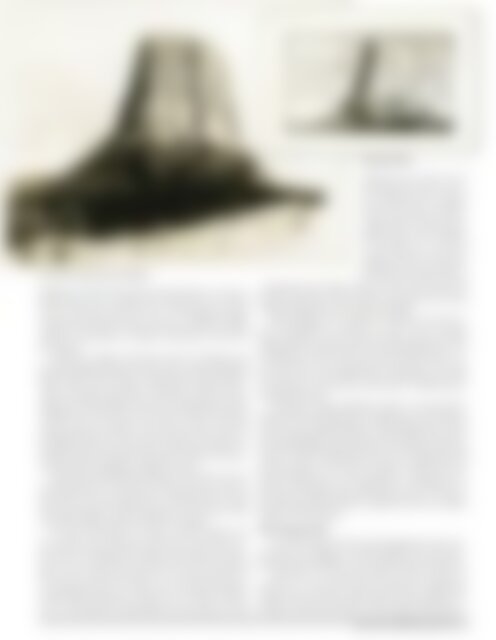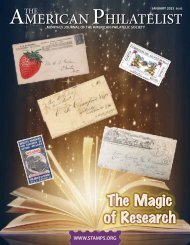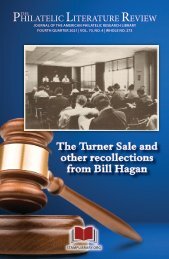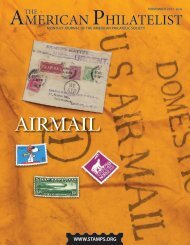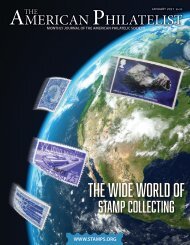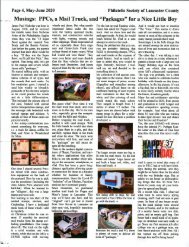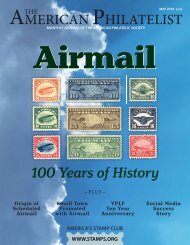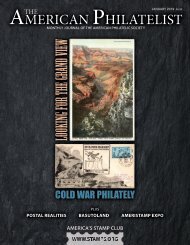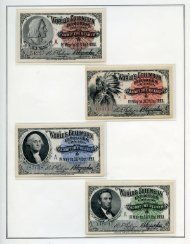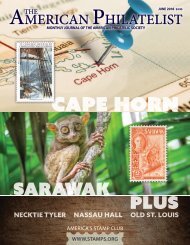August 2018 - Sneak Peek
The American Philatelist is the monthly journal of the American Philatelic Society, the world's largest organization for stamp collectors and enthusiasts. Members receive the printed magazine and can access the digital edition as a benefit of membership in the Society. Please enjoy this sneak peek. We're confident that once you see all that we offer, you'll want to join the APS today.
The American Philatelist is the monthly journal of the American Philatelic Society, the world's largest organization for stamp collectors and enthusiasts. Members receive the printed magazine and can access the digital edition as a benefit of membership in the Society. Please enjoy this sneak peek. We're confident that once you see all that we offer, you'll want to join the APS today.
You also want an ePaper? Increase the reach of your titles
YUMPU automatically turns print PDFs into web optimized ePapers that Google loves.
Rejected design.<br />
Devils Tower stamp source of design.<br />
delegations of both Wyoming and South Dakota, it chose to<br />
honor Devils Tower. Despite what Gregg said, any request<br />
from the National Park Service for an Antiquities stamp<br />
would lack the political clout necessary, and the Post Office<br />
tended to look askance at requests coming from within the<br />
government.<br />
Pushed by “Pappy” and State Senator Al Harding, the<br />
Wyoming legislature piled on the pressure. After liaising with<br />
Bernd in June 1955, senators Frank Aloysius Barrett (1892-<br />
1962) and Joseph Christopher O’Mahoney (1884-1962) adopted<br />
a cunning strategy. First, they convinced their Senate<br />
colleagues to provide the Devils Tower National Monument<br />
with the means to purchase more land in order to develop<br />
camping and other facilities. Once they had Devils Tower on<br />
the agenda, Barrett was easily able to lobby successfully for a<br />
postage stamp. By the following January (1956) he had convinced<br />
26 of his colleagues to support the idea.<br />
Meanwhile, Edwin Keith Thomson (1919-1960), the sole<br />
Wyoming member of the House of Representatives, had not<br />
been idle. He not only pushed for a commemorative stamp<br />
but also provided Post Office authorities with a picture of the<br />
tower that could be used as the basis for a design.<br />
By early 1956 Barrett was able to inform “Pappy” that<br />
“our chances have improved a great deal” and that the authorities<br />
were leaning toward June 8 as the date of the firstday-of-issue<br />
ceremony. He cautioned that the final decision<br />
had yet to be taken and hinged on a successful outcome of<br />
a meeting between his secretary and Assistant Postmaster<br />
General Albert Robertson, which was to be held on February<br />
27. The decider, he maintained, was an assurance to the<br />
authorities that Devils Tower<br />
and Sundance had the necessary<br />
infrastructure to support<br />
what they assumed would be<br />
a large influx of tourists, philatelists<br />
and curious members<br />
of the public for a first-day<br />
ceremony. Bernd took up the<br />
cudgels and wrote two letters.<br />
In the first he said that the two<br />
communities had ample resources, and in the second and<br />
cheekier missive he wrote that this was despite the fact that<br />
Congress had hitherto starved them of funds.<br />
These pledges were enough for Postmaster General Arthur<br />
Summerfield to announce on June 5 that a postage<br />
stamp would be issued to mark the 50th anniversary of the<br />
establishment of the Devils Tower National Monument. Given<br />
the lateness of the announcement, the date of issue was<br />
put back to the more logical date of September 24, which<br />
corresponded to Roosevelt’s proclamation establishing the<br />
national monument.<br />
Following a long-established tradition, the Post Office<br />
Department asked the Bureau of Engraving and Printing to<br />
come up with a suitable design for the postage stamp. Armed<br />
with a photograph of Devils Tower furnished by the Information<br />
Branch of the National Park Service, and others from the<br />
archives, Charles Chickering, the Bureau of Engraving and<br />
Printing designer, set to work to produce a model. Two very<br />
similar compositions were submitted for consideration by<br />
the Bureau of Engraving and Printing on June 26. The postmaster<br />
general selected what he regarded as the more suitable<br />
design the following day.<br />
The Design Itself<br />
Overall, the design of the stamp disappointed some commentators.<br />
Its saving grace was the adoption of a vertical format<br />
eminently suitable to conveying the majesty of the tower.<br />
There also is too much text and too much variation in<br />
typeface for a successful, unified, uncluttered composition.<br />
Centered across the top of the vignette is the wording “U.S.<br />
Postage” in white-faced Gothic. The wording “50th Anniver-<br />
AUGUST <strong>2018</strong> / AMERICAN PHILATELIST 769


